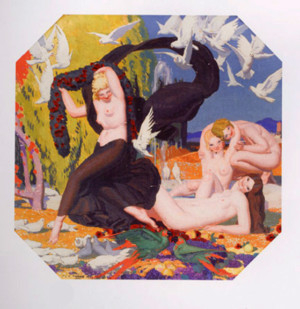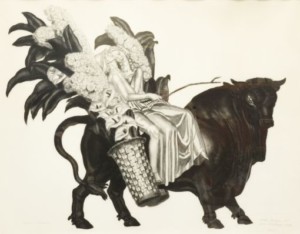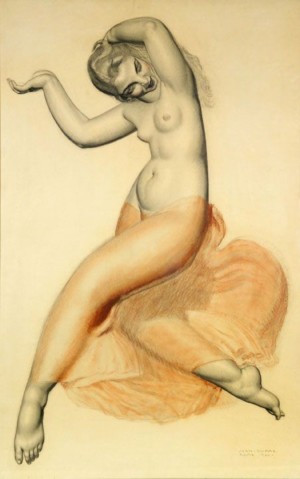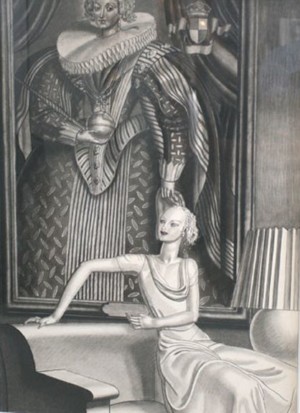(1882-1964)
Jean Theodore Dupas was born in Bordeaux on February 2, 1882. He was a designer, poster artist, and decorator, but above all, he is the painter most closely associated with the Art Deco period. Dupas was part of the Bordeaux School, which included other renowned artists, such as Robert Eugene Pougheon, René Buthaud, Jean Gabriel Domergue, Raphael Delorme, and his close friend and collaborator, Alfred Janniot.
In 1910, he won the Prix de Rome, and spent two years in Italy. It was here that he completed “Le Danse”, a study for a larger painting titled, “Les Pigeons Blanc” (The White Pigeons). This was Dupas’ final painting in Rome, and marked the end of his four year residence at the Villa Medici. This painting was presented in 1922 at the Salon des Artistes Français, where it was awarded the gold medal. It is thought that this painting established Dupas as a successful painter. According to Romain Lefebvre, this work was inspired by Ingres’ “Turkish Bath“, and this is the first example of an Art Deco painting “with the indicative stylization of the figures, almost sculptural, with their long necks and bent wrists forming large arabesque movement.” The actual painting, “Les Pigeons Blanc” (The White Pigeons) has been lost and“Le Danse” is the only remaining evidence of that masterpiece.
One of Dupas’ earliest commissions came from the Bordeaux industrialist Henri Frugès in 1912. Frugès was in the process of renovating his new townhouse, which he called the “Palais Idéal”, and was looking for artists with a modern vision to help him turn his home into a showcase for the finest in contemporary art. He employed Daum Freres, Jean Dunand, Edgar Brandt, René Buthaud and, of course, Dupas to help him make his vision a reality.
In 1925 Dupas participated in one of the most heralded exhibition of all time, the Grand Exposition Internationale des Arts Décoratifs et Industriels Modernes in Paris, from which derives the term Art Deco. At this show, he exhibited “Les Perruches“, not only one of his most famous paintings, but perhaps also one of the defining paintings of his career and perhaps the most well-known of the Art Deco movement. This painting was part of Emile-Jacques Ruhlmann’s Hotel d’un Collectionneur. This was not the first time that Ruhlmann collaborated on a project with Dupas, and certainly not the last.
Dupas is also known for decorating the interiors of the Île-de-France and the Liberté, as well as the SS Normandie, in 1934, for which he created fabulous verre eglomisé panels for the Grand Salon. Portions of this mural are now on display at the Metropolitan Museum of Art and also at the Forbes Galleries in New York.
It is hard to view a painting of Dupas’ without thinking of his grand scale murals. Dupas falls into the category of peinter-decorateur, a term describing many artists throughout the nineteenth-century who participated in the discussions accompanying the extensive redecorating that Paris was undergoing at the time. His teacher, Albert Besnard, was one of the most renowned of these academically oriented muralists, who favored highly allegorical and historical subject matter which they considered appropriate to convey the loftier message appropriate to the monumental places where they would be seen.
Dupas studied under Besnard at the turn of the century, when the latter was interested in Impressionism. Many of the Post-Impressionists were interested in murals as sort of a flirtation with the decorative arts. Dupas, charged with the decoration of many great buildings in Paris in the nineteen-twenties, continued in this tradition. The style he used seems to epitomize the Art Deco movement. Great mural art is, unfortunately subject to impermanence due to fires and new paint jobs. Two of Dupas’ chef d’oeuvres were in the French Pavilion of the New York World’s Fair and in the Grand Salon of the Normandie.
His style, based on the new precepts of Cubism, is related to that of Van Dongen, de la Fresnaye, and Leger. Dupas’ treatment of space often creates a surrealist, idealized pastoral landscape as a setting for his figures, gracefully distorted by elegant elongation.
The “Dupas look” dominates advertising and commercial art throughout the whole of the Art Moderne period. In fact, Dupas did a great quantity of posters and other advertising work. His work also frequently appeared in fashion magazines such as Vogue and Harper’s Bazaar, and he also created a catalogue for the furrier Max, in 1927, which is considered to be a “masterpiece of print advertising.” It is easy to recognize a “Dupas woman” – the hair is cropped, her eyes are almond shaped, the mouth is small but full, and her neck is always elongated.
Dupas became a member of the Académie des Beaux-Arts in 1941.
An interesting fact, but perhaps not well-known, is that Andy Warhol was a big fan of the artist’s work, along with the Art Deco period in general, and collected his work extensively.
Showing all 4 results





